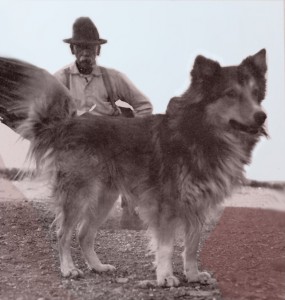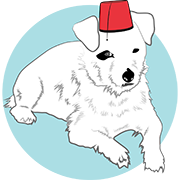As you will soon discover, the story I’m posting here today isn’t primarily about Wyatt Earp’s dog; he’s a minor character. But not only is his the only image I have, but the attempt to identify his breed — border collie mix, as it turned out — led to a colorful story about a lookalike dog, which I will post tomorrow. Or soon.
And let’s face it, Wyatt Earp is a superstar of Old West history, more of a web traffic generator than, say, Charles Fletcher Lummis, whose dog plays a greater role.
So with my apologies for adding a sensationalist title, I turn my blog over to my historian friend, Jim Turner, who told me he’d come across some interesting dogs in the course of his research. Naturally, I enlisted him to write about them for me.
Get Along Little Doggies
Tales of the Wild West are studded with cattle, horses, coyotes, and the occasional mountain lion, but there’s a dearth of faithful canine sidekicks. Everyone knows about the gunfight at the O.K. Corral, for example, but few are aware that Wyatt Earp and his wife Josie spent their later years prospecting in Alaska and the Mohave Desert — in the company of their border collie mix.

His name? Why, “Earpie” of course! He was lucky to hook up with Wyatt after the bullets stopped flying.
Not all frontier dogs had it so good.
Consider the less fortunate Shadow, the dog of journalist Charles Fletcher Lummis. In 1884, Lummis began sending dispatches from points along his 3,000-mile trek from Ohio to California; awaiting at the journey was the job of city editor of the Los Angeles Times. Among his stories is one of how, south of Denver, he adopted a starved and beaten coal-black greyhound pup, which he named Shadow. After some nasty nips the dog finally settled down and became a loyal friend. The two bonded, even though Shadow sometimes scared off wild game that could have been dinner.
Then two months down the road, in the middle of the Mohave Desert, Shadow began to act strangely — and dangerously.
Lummis initially fended off the attack that must have been the result of a case of rabies, then called “hydrophobia.” But, Lummis writes, Shadow “was upon his feet again in a second, and dashed at me with a growl that froze my blood. I saw his white teeth shining, while from his jaws dripped a thick froth. . . . the dog was mad.” Lummis shoved Shadow away again, but on the next attack he drew his heavy Colt revolver.
His aim was unsteady as “it had come to me that I was driving a bullet into my dear faithful friend.” Lummis had to fire a second shot as the dog ran away to save him from a slow desert death. Then Lummis sat down and wept. He’d seen a good many friends die, but “precious few of them left me as sore and sad as did that poor, loving dog.”
Railroads and automobiles tamed the frontier, but 80 years later another sojourner took to the road with his dog. This one was a standard poodle with his name on a Nobel-Prize-winning book – Travels with Charley.
“He was born in Bercy on the outskirts of Paris and trained in France, and while he knows a little Poodle-English, he responds quickly only to commands in French. Otherwise he has to translate, and that slows him down,” John Steinbeck wrote.
The two traveled 10,000 miles around the edges of America, from Maine to California and then back through Texas and the South, until they’d come full circle. At one point, Charley’s canine instincts went berserk as he barked fiercely at a bear in the road in Yellowstone National Park, but the rest of the time he was an easygoing travel companion.
Near Amarillo, Charley took sick and had to stay in a veterinary hospital for a few days. Steinbeck got an inkling of what life would be like without his companion, but luckily he was saved Lummis’ ordeal. Steinbeck didn’t mention Charley all that much in his book, but he didn’t have to. The big poodle was just there, loyal as the countless frontier dogs before him.
Bio: Jim Turner has lived in Tucson all of his life (so far). He began teaching Arizona history in 1976, and recently retired from the Arizona Historical Society. Jim is teaching Arizona history for Pima Community College this fall, and writing “Celebrate Arizona,” a pictorial history book. He gives presentations on more than fifty topics for local clubs, conferences, and meetings. You can learn more about these projects and read more Arizona stories at www.jimturnerhistorian.org

One thought on “Wyatt Earp’s dog”